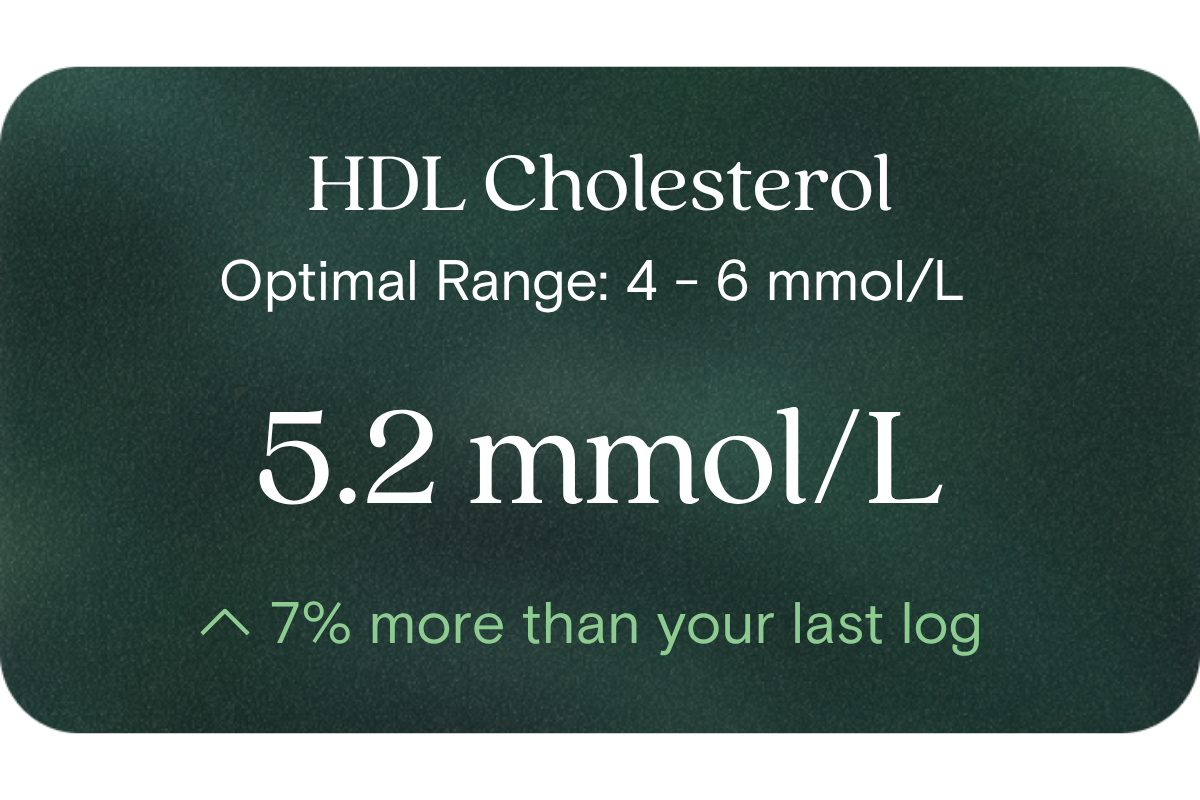What is HDL cholesterol?
HDL stands for high-density lipoprotein. It is a class of lipoprotein particles that carry cholesterol in the bloodstream. Unlike other lipids that may deposit cholesterol in vessel walls, HDL tends to act as a “cleanup” vehicle, fetching surplus cholesterol and delivering it back to the liver for breakdown or elimination.
Why does it matter for long-term health and well-being?
HDL plays a balancing role in lipid metabolism. Higher HDL levels are associated with better cholesterol handling, less accumulation in arterial wall linings, and a more favourable metabolic profile. Over time, tracking HDL gives you a window into how well your body is maintaining vascular and metabolic balance — an important contributor to energy, resilience and longevity.
What’s an optimal level of HDL cholesterol?
- Laboratory / reference thresholds: ~ > 1.0 mmol/L for men, ~ > 1.2 mmol/L for women
- Optimised / performance target: Many experts consider a value above 1.0 mmol/L in men and 1.2 mmol/L in women as a more robust, beneficial threshold.
Note: “higher is better” up to a point, but HDL should be viewed in the context of your full lipid profile and metabolic state.
What influences HDL levels?
HDL levels are shaped by a mix of genetics and lifestyle factors. Key modulators include:
- Physical activity and exercise (especially aerobic and resistance training)
- Body composition and fat distribution
- Dietary fat quality (e.g. more mono- and polyunsaturated fats, less trans fats)
- Alcohol intake (in moderation, where applicable)
- Smoking status and exposure
- Hormonal status, age and sex
- Sleep, stress and systemic inflammation
- Other lipid parameters (e.g. triglycerides) — interactions matter
What does it mean if HDL is outside the optimal range?
- Below optimum: A lower than optimal HDL suggests that your body’s capacity to remove excess cholesterol is relatively weakened. It signals a potential imbalance in lipid dynamics, and may flag an opportunity for lifestyle adjustments.
- Above typical high: Exceptionally high HDL is uncommon and in most cases is not harmful, but unusually elevated levels may merit context evaluation (e.g. whether HDL is functional).
In all cases, HDL should be interpreted in light of your full lipid profile, your metabolic parameters and your trend over time — not in isolation.
How can I support healthy HDL levels?
- Engage in regular physical activity (aerobic + resistance training)
- Improve body composition (lean mass, reduce excess adiposity)
- Focus on dietary fats: include sources of omega-3, monounsaturated fats (e.g. olive oil, nuts), and reduce trans and processed fats
- Moderate alcohol, if consumed, in line with guidelines
- Quit or avoid smoking
- Prioritise good sleep, stress management and inflammation control
- Address other lipid parameters (e.g. lower triglycerides) so that the overall lipid environment supports HDL function
- Track trends over time and adjust interventions gradually
By measuring and tracking HDL cholesterol now, you gain a window into how well your body is managing cholesterol balance today — giving you early, non-hyped insight, and the ability to adjust lifestyle in a targeted way before larger issues emerge.
This information is provided for general health and wellness purposes only and does not replace medical advice.
FAQs
How do I raise HDL cholesterol?
If you are asking how do I raise HDL cholesterol, the most effective levers are regular physical activity, improving body composition, and choosing healthier fats such as olive oil, nuts, seeds, and oily fish. Consistent movement, especially aerobic and resistance exercise, is one of the strongest drivers of higher HDL over time.
What is non-HDL cholesterol and what does it mean?
Non-HDL cholesterol meaning refers to all cholesterol carried by lipoproteins other than HDL, including LDL and other atherogenic particles. It represents the total cholesterol that can contribute to plaque build-up and is often used alongside HDL to give a fuller picture of cardiovascular and metabolic risk.
Why is HDL interpreted alongside other cholesterol markers?
HDL works as part of a broader lipid system rather than in isolation. Looking at HDL together with LDL, non-HDL cholesterol, and triglycerides helps clarify whether cholesterol transport and clearance are balanced, and whether lifestyle changes are improving overall lipid health rather than just one number.
References
- “HDL cholesterol testing: implications for clinical management,” Australian Prescriber
- RCPA Manual – HDL cholesterol reference interval > 1.0 mmol/L (men), > 1.2 mmol/L (women)
- Pathology Tests Explained – healthy HDL-C > 1 mmol/L
- AIHW – HDL < 1.0 mmol/L women < 1.3 mmol/L flagged as abnormal




















.png)
